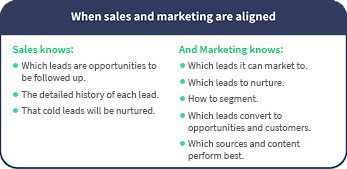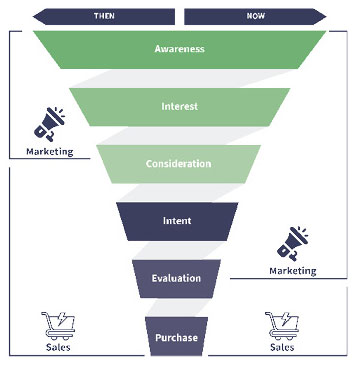We help you modernize outdated sales and marketing processes to a build a better sales pipeline and accelerate growth.
Our team would be happy to discuss your goals on a 30 minute, no-pressure, value-focused video call.
Pre-internet, when the only way for B2B customers to learn about new products was to talk to the people selling those products, marketing and sales teams were distinct, with clear lines separating the two functions. The marketing team existed to generate leads for sales. And, when everything went to plan, the sales team would turn those leads into sales.
This siloed approach to marketing and sales simply doesn’t work in today’s marketplace where B2B customers have easy access to information about products, and only talk to salespeople when they’re ready to buy. According to global research and advisory firm Gartner, 83% of the buying journey is completed before purchasers meet with a salesperson.
More importantly, today’s modern buyers don’t want to be sold to, they want to be supported. They want personalized information that will help them decide on the best solution for their business. They also want help making the case to their buying committees for the purchase.
This new reality requires sales and marketing teams to work together as partners. They have to develop a crystal clear understanding of their ideal customer profiles, what these potential customers’ challenges and opportunities are, and where they are on the new buyer’s journey. More than this, marketing and sales have to have shared goals and metrics to ensure they’re moving in the same direction. Research shows when marketing and sales are aligned around the customer and goals better results follow.


The problem? This alignment is not happening. The same report reveals that 9 in 10 sales and marketing leaders say they are misaligned around strategy, process, content and culture. There are a number of reasons for this, most notably, poor communication, flawed processes, separate goals and metrics.
When marketing and sales are not aligned, the business pays the price. According to the Content Marketing Institute, from 60% to 70% of B2B content is not relevant to buyers and so it’s never used. Not only is all of the effort creating this content wasted, HubSpot reports the lack of synergy between marketing and sales means 79% of marketing leads do not convert.






Simply put, sales and marketing alignment is the process of creating synergy between sales and marketing and making sure both departments are operating together. This requires the two functions to be working towards shared goals and delivering on shared strategies. It also means they have equal accountability when it comes to achieving these goals and ultimately driving revenue growth.
This is easier said than done for a few key reasons. Sales is focused on the short-term, as it works to meet quotas. Marketing is playing the long game, as it works to enhance brand awareness. As well, when it comes to lead generation, sales wants quality leads, while many marketers are focused on delivering the most leads possible.
Still, the time and effort to bring sales and marketing together is worth it. Research shows, when sales and marketing are aligned, good things happen. Conversion rates and forecast accuracy improve, sales cycles shorten and productivity, revenues and profits increase.
One way to help build alignment is through sales enablement. This is the ongoing process of giving your marketing and sales teams the tools and meaningful data they need at each stage of the sales cycle to close deals.
This support is critical to help sales nurture leads and meet the needs of today’s B2B customer. High-quality leads and relevant, timely content from marketing is what will help sales teams build trust with multi-person buying committees who will decide to buy your product or not.

B2B companies that fail to align their sales and marketing teams lose 10% or $1 trillion in revenue each year because of decreased sales and productivity, and wasted marketing efforts.
Conversely, B2B companies that have achieved a high degree of alignment between their sales and marketing teams attain 38% lead-to-sales conversion rates. This is a huge improvement over current benchmarks. According to Salesforce, on average, 13% of leads convert to opportunities and only 6% of opportunities convert to deals. Even more impactful: highly aligned businesses achieve 27% faster threeyear-profit growth and 208% greater marketing revenue.
When sales and marketing align, revenue increases, the sales cycle shortens, and conversion rates improve along with forecast accuracy. That’s because they are communicating, and sharing information and insights, which makes them better able to act on fast-changing customer demands and expectations.

Today’s complex buying cycle introduces new challenges for marketing and sales alike. For example, according to Gartner, sellers have a very small window to influence buying decisions. B2B buyers spend only 17% of their time with sellers when considering a solution. This drops to 5% or 6% if they’re considering multiple products. Plus, the typical buying group for a complex B2B solution involves six to 10 decision makers‚ who each bring their own research to the table. At the same time, the number of options they’re considering continues to grow as new technologies enter the market.
However, when sales and marketing align, many of these problems can be resolved.

Our friends at HubSpot have helped identify four prime signs that sales and marketing are not aligned:
One of the biggest barriers to aligning sales and marketing is the gap between sales and marketing goals. For example, when marketing is focused almost solely on generating Marketing Qualified Leads (MQL) and views lead generation as a numbers game, then it is not considering sales’ ability to convert those leads into customers. To be fair, MQLs are the key measure of performance for marketing teams, while closed deals are what success looks like for sales teams. This puts more pressure on sales.
To close the gap, marketing departments should set revenue goals based on closed deals. This will help them present better leads to sales and keep both teams on the same page.

Regular, meaningful interaction and communication is crucial to bringing sales and marketing together as a cross-functional team. Having both teams siloed just doesn’t work when it comes to capturing the attention and business of today’s B2B buyers. Rather, both teams have to understand each other, what they’re working towards and how they plan to get there. Without this understanding, it’s easy to get off track and off task, causing tension and less than optimal performance.

While sales and marketing each have their own pressures and targets, it’s also important they support each other to achieve shared goals. These shared goals can serve as a conduit for collaboration and an opportunity to better understand each other
Get a handle on the big picture. Work together to brainstorm ways to improve the entire sales process and pipeline. Typically, marketing is responsible for the beginning stages of the sales process and sales is responsible for the latter half. Bringing everyone together to assess how the entire process works, and what happens at each stage, will improve overall understanding, highlight how one stage impacts the next, and could lead to better, more effective ways of operating.
If your sales team creates its own “sales content” and refuses to let marketing to step in and take this on, your teams are misaligned. If marketing doesn’t accept input from sales on content creation, your teams are misaligned.
Sales and marketing should approach developing content together. Sales can provide important insights on the type of information potential buyers want at each stage of the sales cycle and preferred formats. Marketing can then use this information to create content that is relevant and impactful.

How you go about aligning sales and marketing will be unique to your business, however, there are some key components and fundamental steps that are universal.

Aligning sales and marketing around business goals makes it easier and more efficient to identify, qualify, nurture and convert leads. This doesn't mean each department won’t have their own goals. It does mean they will understand each other's goals, that these goals do not conflict, and that each department understands how these goals are connected and work together to deliver on business goals.
Establish an ongoing feedback loop. This should include regular meetings, shared communication tools to track touchpoints and contacts, and a plan that makes both groups accountable for progressing leads through the sales cycle.
Set measurable goals.
Develop clear understanding of the criteria for Marketing Qualified Leads and Sales Qualified Leads.
Determine which leads will be handed to sales and how sales will follow up on these leads.

A clearly defined picture of who your target customers are will help sales and marketing better identify and manage leads throughout the sales cycle and enable both teams to measure how their initiatives are working and improve.
Sales and marketing should work together to create Ideal Customer Profiles (ICP) and buyer personas for each of your products.
PRO TIP: An ICP is a fictionalized company that represents the type of businesses that need your product or service to become more efficient, resolve a problem or make the most of an opportunity. Your ICP should include firmographic factors (industry, annual revenue, location, company size, budget and stage in the sales cycle) or characteristics that reveal why this company is the right for your product.
A buyer persona is a fictionalized description of the people or roles in your ICP that you will be selling to. These are the people making the buying decisions. It’s important that both sales and marketing have a clear picture of who they are, their job title, role, the problems they’re trying to solve, and their goals.


The only way to improve your win-loss ratio is to closely examine each aspect of your sales cycle, identify shortcomings and set goals to fill the gaps and improve.
Analyze prior sales and marketing performance. Look for patterns. What led to a closed sale? What led to a lost sale?
Assess the effectiveness of your current sales and marketing processes. What’s working? What isn’t? Can a process be improved or should it be deleted? Is something new needed? Use this information to create an effective, repeatable process to generate and convert leads.
Determine if there are any holes in your strategy. For example, are you targeting the right buyers? Is your messaging relevant? Are you effectively positioning the sales team as trusted advisors?
Talk to your customers. Find out if they’re happy with how you’ve been engaging them, the information you’ve provided, the timeliness of responses to questions.
Sales and marketing should work together to create Ideal Customer Profiles (ICP) and buyer personas for each of your products.
PRO TIP: An ICP is a fictionalized company that represents the type of businesses that need your product or service to become more efficient, resolve a problem or make the most of an opportunity. Your ICP should include firmographic factors (industry, annual revenue, location, company size, budget and stage in the sales cycle) or characteristics that reveal why this company is the right for your product.
A buyer persona is a fictionalized description of the people or roles in your ICP that you will be selling to. These are the people making the buying decisions. It’s important that both sales and marketing have a clear picture of who they are, their job title, role, the problems they’re trying to solve, and their goals.
Analyze prior sales and marketing performance. Look for patterns. What led to a closed sale? What led to a lost sale?
Assess the effectiveness of your current sales and marketing processes. What’s working? What isn’t? Can a process be improved or should it be deleted? Is something new needed? Use this information to create an effective, repeatable process to generate and convert leads.
Determine if there are any holes in your strategy. For example, are you targeting the right buyers? Is your messaging relevant? Are you effectively positioning the sales team as trusted advisors?
Talk to your customers. Find out if they’re happy with how you’ve been engaging them, the information you’ve provided, the timeliness of responses to questions.

This will set expectations for marketing and sales, as well as provide the action steps necessary to progress from one stage of the sales cycle to the next. A repeatable sales process also allows sales and marketing to track and measure their efforts and adapt as necessary.
Build your sales process into your marketing platform and CRM system. This will help you keep track of prospects and ensure sales follows up on marketing qualified leads.
Establish Key Performance Indicators and set targets that move both teams towards achieving shared business objectives. For example, key metrics should include revenue, MQL to SQL conversion rate, SQL to customer conversion rate, the length of the sales cycle, content effectiveness and use
Define which leads will be handed to sales and how sales will follow up on these leads.
Make sure that demand generation flows through each stage of the sales cycles. This will require both marketing and sales to be clear on the tools that will help them keep prospects moving through the sales cycle, what to automate and when to reach out to prospects.
Develop a Lead to Revenue Model, track it with specific metrics, and improve as you go.
Develop Service Level Agreements (SLAs) that clearly outline what marketing agrees to deliver and what sales will do. For example, marketing will deliver X number of qualified leads and sales will follow up on these leads within a specified time frame.


Access to the same information at the same time is crucial to bringing sales and marketing together and working towards shared goals.
Conduct an audit of the information you have and the systems you’re using to capture that data. The two most commonly used technologies by sales and marketing to collect, analyze and track data are Customer Relationship Management systems and marketing automation systems. Make sure these systems are being used correctly and to full advantage, and integrate them. Start by syncing contact data.
PRO TIP: CRM and marketing automation tools can be used to create custom reports and dashboards; track progress through the sales cycle, social media clicks, downloads, etc.; automatically log calls and send templated messages; and update what’s happening with each prospect. Both sales and marketing should co-track key performance metrics they’ve identified together.

The overwhelming majority of B2B buyers (95 percent) choose a solution provider that provides content that helps them navigate through each stage of the buying journey. Businesses that are able to do this effectively have aligned sales and marketing to create consistent brand messaging across all channels and mapped that content to the sales process. Unified, consistent, positive brand messaging across all aspects of the sales funnel is the defining characteristic of well-aligned sales and marketing functions.
Create a comprehensive content strategy designed for both sales and marketing. This will help maximize ROI on the content.
Map content to the buyer’s journey and the sales cycle.
Keep the customer front and center when creating content. Know their pain points and opportunities and develop personalized, relevant content at each stage of their journey.
Implement inbound marketing methods to create content that is useful and will bring customers to you.
Track jointly agreed-to KPIs.
Collect and act on feedback.
Aligning sales and marketing is one of the most powerful ways to compete and grow sales in today’s complex business environment. When sales and marketing are working together, towards the same business objectives, you have a better understanding of your customer, how to connect with them, what they’re looking for, and a better chance of earning their trust and business.
This alignment makes marketers better able to generate, attract and nurture qualified leads with personalized content. It also gives sales reps what they need to convert those prospects.It’s an important shift and one that is proven to improve ROI on marketing initiatives and drive sales growth.
Team Revenue

Contact Us
Copyrights © 2020 Team Revenue